Your chickens will need properly formulated chicken feed that is the correct type for their age, for growth, sustenance and to produce eggs if they are hens of egg laying age. There are many old wives tales and alternative views on feeding, some say it’s marketing that has created all of these feeds and hens will survive well on wheat and others will say their grandad never had layers pellets and just fed his hens kitchen scraps! Formulated poultry feeds didn’t exist until recently, primarily created thanks to commercial research on hens diets as we tried to squeeze more and more eggs out of hens.
In days gone by though when ‘grandad fed scraps’, pure breeds were kept for eggs and they were fed grain mixes or dried mash chicken feed that had meat or fish meal added to increase the protein content. Hens would free range over a large area and could also supplement their diet with what they could forage. Bugs, insects and worms are all valuable sources of protein, not forgetting a good selection of greens providing vitamins and minerals.
“Grandad’s chickens didn’t get chicken feed and survived on kitchen scraps but they could free range to top up their diet on protein, vitamins, minerals and calcium from the fields or orchards they grazed. They didn’t produce anything like the number of eggs modern hybrid hens or some pure breeds produce.”
So in short, if you don’t feed a proper formulated layers feed to your hens, they won’t be able to keep up the demands that egg-laying puts on their bodies.
Layers Feeds and Protein
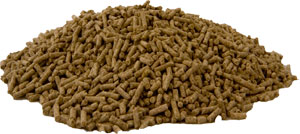 Chickens require protein to produce feathers and eggs as well as to grow. The amount of protein in their diet is important and you will see on the ingredients on the back of bags of commercial feeds the percentage of protein that they contain. It is higher in ‘Growers Pellets’ for example to enable chickens to grow and produce feathers. You will find that chickens stop laying eggs when they moult (lose their feathers and regrow new) as they are diverting protein from egg production to feather production. During the moult, you can scatter a handful of cat kibble in the run which helps them to top up with protein. Do not use dog food as most of the protein is derived from cereals.
Chickens require protein to produce feathers and eggs as well as to grow. The amount of protein in their diet is important and you will see on the ingredients on the back of bags of commercial feeds the percentage of protein that they contain. It is higher in ‘Growers Pellets’ for example to enable chickens to grow and produce feathers. You will find that chickens stop laying eggs when they moult (lose their feathers and regrow new) as they are diverting protein from egg production to feather production. During the moult, you can scatter a handful of cat kibble in the run which helps them to top up with protein. Do not use dog food as most of the protein is derived from cereals.
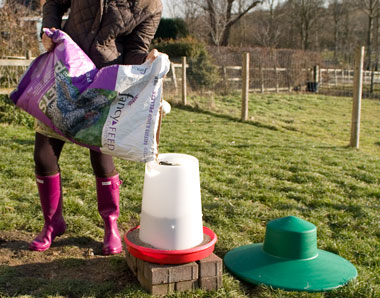
Commercial feeds contain the right balance of nutrients & can be fed ad-lib in hoppers if kept dry. This one has a rain hat.
Commercial chicken feeds have been well researched and contain the correct balance of minerals and nutriets required by chickens as well as sufficient protein and calcium which is essential for egg shell production. Layers pellets for example are around 16% protein. Wheat is about 10% protein and lacks essential vitamins that are required by chickens.
Formulated feeds come as pellets or mash and should be fed ad-lib so hens can take what they want as they need it. This type of feed must be kept dry or it will soon spoil. The feeder and rain hat shown above is the only sort I have found that really does keep the feed dry. Most have a hole in the top of the hat for a handle or for hanging and this lets water in. A feeder and rain hat similar to this one can be bought from Omlet.
Eggs are made up of around 80% protein so if there’s a shortage of protein in their diet, egg laying will be the first thing they your girls cut back on!
There is more information on the poultykeeper.com site which has a very good page of feeding chickens and chicken feed.
Mixed corn
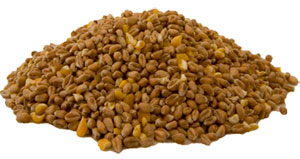 Mixed corn is usually 80 to 90% wheat and 10 to 20% maize. It is useful as a scratch feed, it keeps hens active, scratching around looking for it but should only be considered a treat. A handful per hen thrown late afternoon helps them to have a full crop overnight.
Mixed corn is usually 80 to 90% wheat and 10 to 20% maize. It is useful as a scratch feed, it keeps hens active, scratching around looking for it but should only be considered a treat. A handful per hen thrown late afternoon helps them to have a full crop overnight.
The maize (yellow in colour) is very fattening but can be useful during very cold weather to help your hens keep warm – I increase my girls’ ration of corn when it is cold over the winter, after they have finished moulting (they need lots of protein during the moult) since they are not laying eggs and need a little extra fat to burn in order to keep warm.
If you feed too much corn, your hens will get fat and fat hens don’t lay eggs!
Household scraps
Feeding household scraps is no longer allowed according toi DEFRA and can be a bit hit and miss anyway. You don’t really know what a hen is getting and the diet is very unbalanced. It is for this reason that scraps used to be mixed into a mash by using layers mash and water (which can be warm in winter). The mixture should be a sort of crumbly mix, not too wet but not too dry. Feeding scraps should be limited to at most 25% of a hens diet so as not to tip the balance too far one way or another.
Greens
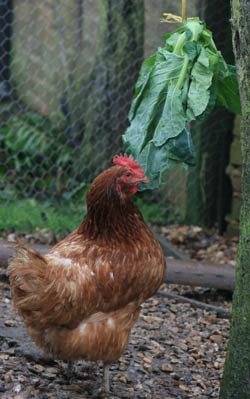 Ample green stuff should be provided for your hens. Grass cuttings, weeds and off-cuts from cabbages, cauliflowers and other greens can be provided at minimal cost. Lettuce should be fed in moderation because it has very little nutritional value (very little Protein and Energy / Calories) and avocado pear is poisonous to hens but most other greens that come from the kitchen will be appreciated by your girls. Try hanging greens in their run, just a little higher than they can reach. As they eat them, they will need to jump to get the last bits so will be getting exercise at the same time as their greens! Win-win!
Ample green stuff should be provided for your hens. Grass cuttings, weeds and off-cuts from cabbages, cauliflowers and other greens can be provided at minimal cost. Lettuce should be fed in moderation because it has very little nutritional value (very little Protein and Energy / Calories) and avocado pear is poisonous to hens but most other greens that come from the kitchen will be appreciated by your girls. Try hanging greens in their run, just a little higher than they can reach. As they eat them, they will need to jump to get the last bits so will be getting exercise at the same time as their greens! Win-win!
If you have an area in which you can grow cabbages in your garden, it may be worthwhile thinking about growing a row for the winter. Cabbages will sit there in the cold, perfectly preserved until picked. You will need to keep them covered with fleece when there are cabbage white butterflies around but don’t worry if they are a little eaten, the chooks won’t mind!
Mealworm treats
Many chicken keepers like to buy mealworms or chicken treats containing these. Chickens love these and are easily tamed by using such tasty treats, however you should keep in mind that animal by-product regulations mean that mealworms are not really allowed to be fed to poultry.

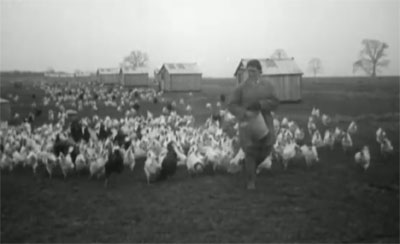
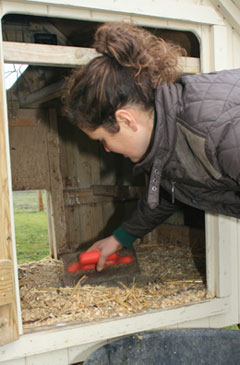
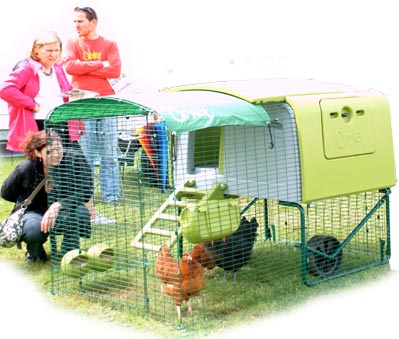
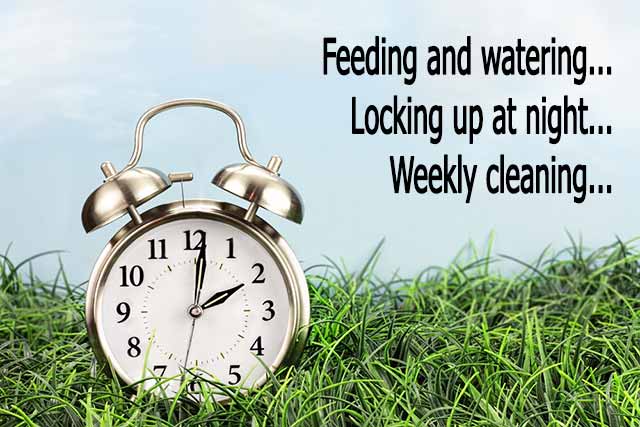
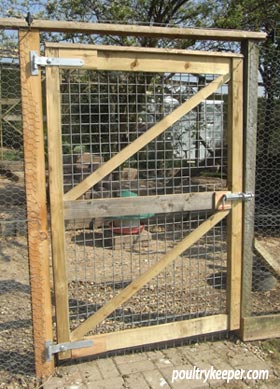
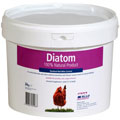
OK guys i need your help asap please, i have a poultry farm which i just started and i have 1000 birds which i breeds from day old, i normally feed them 2x 25kg bags of layers feed and the chickens are 25 weeks old now but no eggs, one of the chicken was laying egg every 3-4 days and only laids 3 eggs within two weeks before she stop laying. i need the right info as soon as possible as they driving me crazy now, now another one start laying eggs and it every 3 days too. can it be the food or can it be that the food is not enough for the birds, can someone tell me please how many 25kg bags a 1000 birds should eat, any advise/info will help thank you.
I’m sorry, I only keep backyard chickens in small numbers.
We feed ours ad-lib, they will not over-eat the pellets.
Check protein levels in the feed – 16-17% should be enough for layers.
Hi Kofo, you do not say which region your farm is in, and i have to assume there is limited free range feed. I would feed growing 10 week old’s with at least 225 gram each per day, plus whatever they get at free range. When they are laying, they will need more. you need to give them probably three times what they are getting now.
Hello! just found your site . . its brilliant!
We have 2 Bluebell chickens and 3 lovely 16 week “chicks” that we watched hatch! My hubby’s school had them in a classroom and they were due to be picked up but he fell in love with a chick with a twisted foot. We knew what would happen to it and we decided to bring it home to see what we could do with her, bringing her 2 sisters with her! He fixed her foot (thanks to the internet) as they were so small, they lived in my craft room under a light, the area got bigger and bigger and eventually no room for me!
Eventually we introduced them to the Bluebells (not the nicest breed) and our 3 Aylesbury ducks, the Bluebells are bullies! They’ve been on growers pellets, when can they go onto layers and will anti pecking spray help??
Many thank yous for your time. Ooh and we have a wild mallard duckling that was rescued from a cats mouth. Any ideas on how to build her up before she flies away and leaves us? I’ve had her 3 weeks and she was a tiny ball of fur when I was given her.
Keep the chickens on growers pellets until they are ready to lay (about 19-22 weeks old), you want them to grow as much as they can before they start laying. They only need layers pellets when laying because it has a lot of Calcium in it.
Anti pecking spray can work but they do need to establish the pecking order. Only mix hens the same size or there will be more bullying and the smaller birds will suffer.
The duckling needs crumb for 3 weeks (must be unmedicated chick crumb or waterfowl crumb) then unmedicated growers pellets (eg Fancy Feeds or Smallholder Range).
It will need heat for about 4-5 weeks then should go outside on grass. Only give bath water for a short time each day so it doesn’t get wet and cold before bed.
Good luck!
I am confused to what is deemed kitchen scraps and can not be fed to chickens and what is not!
Please can you clarify what is kitchen scraps, is it just left over food that is taken from unfinished plates or any unused food from the kitchen.
Technically anything that passes through your kitchen must not be fed. This is why I say ‘allotment scraps’ are fine to feed because if they don’t go through your kitchen, you are OK.
In reality, I’m sure most back-garden chicken keepers use common sense, I know many that feed scraps…
Hi, I’m new to keeping hens+ I have taken 2 rhode Island reds and a bantom on, from re-home. All settled really well, I’ve had them 4 weeks now. 1 of the reds produced a double yolk egg, + has had trouble since. She had stopped laying for a while, think she thought it was winter, now she’s laying again, the eggs are soft shells and the 3 are eating them quick before I can get to them. They are all feed the same, layers pellets, grit with corn as a treat, and free range in the veg garden for a couple of hours when I’m working in there. She is tame, no sign of illness, ready to come out of the hen house in morning and happy to go back in, no obvious change to her life, can you advise please!
Soft eggs are fairly common at the beginning or end of their laying period and the odd few soft eggs are nothing to worry about. Ideally collect them before the others find them. There can be medical reasons behind continual laying of soft eggs (eg problems absorbing calcium in the body) and I haven’t heard of a cure for this but it is very rare, normally, they will go back to normal when they have a good diet with sufficient calcium from the layers pellets.
Hi can you feed things like bacon rind and peas/ sweet corn and what about fruit? I am adopting two polish chickens and am doing some research on them as they are in poor condition and I need to give plenty of nutrients to get their condition up before winter sets in.
Don’t feed meat, it’s not permitted by DEFRA.
To get them into condition, don’t overfeed the treats! Make sure they get a good quality layers pellet (or even better breeders pellets like these which have extra nutrients in them). Then feed a handful of fresh greens in the afternoon after they have had their corn. Allow them to free range a little too if you can. Grass is very good for them. If you feed mixed corn, don’t give them more than a handful each afternoon or evening before bed. Ensure they have fresh water every day. Apple Cider Vinegar is wonderful too in their water (see my page on this for more info including the right sort to buy).